![Best AR-15: Top Options Available Today [Field Tested] Best AR-15: Top Options Available Today [Field Tested]](https://gundigest.com/wp-content/uploads/Harrington-and-Richardson-PSA-XM177E2-feature-768x496.jpg)
We comb through the mountains of carbines to bring you the best AR-15s out there today.
White-hot as a plasma cutter, that’s how it was around a decade ago. When everyone was certain politics would quash ownership, demand for AR-15 rifles got so out of control the most basic models moved for an insane price. A grand, sometimes more. Hard to believe, but true.
Outside of recent events of pandemic proportions—Covid 19 and the election of politicians hostile to gun rights—Americans’ appetite for the handy rifle has been somewhat slaked. Certainly, shooters still love to build and buy Eugene Stoner’s masterpiece. But they aren’t donning their high school baseball spikes to trample over the rest of the market to nab one. In a word—again outside recent events—the market has normalized.
The performance of the AR-15 has not. In fact, given the wealth of top-rate ammunition, excellent upgrades and plenty of quality pre-built options, the rifle is better than ever. Spend the money and you can almost guarantee something tailored exactly to your needs. It’ll shoot like a laser beam and be built to hand down to a son or daughter. The other end of the price spectrum isn’t shabby either.
Entry-level models, though not tuned to the level of perfection of the top-shelf stuff, are still worthy investments—especially if you’re new to the AR-15 game. Yeah, you’ll most likely have a gritty mil-spec trigger out of the box and the handguard will be more Honda Civic than Corvette. But the rifle itself will hold its own well enough for home defense, target practice or even to fill a survival-gun role.
That said, we’ve collected 8 of the best budget AR-15 options that more than fit the bill for these applications and any others you might cook up. Our ceiling for this article is $1,050, which nets you a pretty good rifle, believe it or not
How I Chose The Best AR-15
Throughout my career, I’ve been lucky enough to shoot a wide swath of the AR-15s available on the market today. I have trained, competed and hunted with what has become known as “America’s Rifle”, and become intimately familiar with the platform. In short, I know the AR-15 and what makes a good one.
With that said, I and the Gun Digest team winnowed down the expansive field of the icon carbine to these choices through extensive testing. Through hundreds of rounds, special attention was given to reliability, accuracy, ergonomics and, in some cases, innovations. Price, for certain categories, was also taken into account. In the end, these were the carbines that our magazine's team and I found the best AR-15s.
Best AR-15s
Best Mid-Tier AR-15 (Editor's Choice): Springfield Armory SAINT Victor
Best Premium AR-15: SOLGW M4-76
Best Entry-Level AR-15: Smith & Wesson M&P15 Sport III
Best Budget AR-15: Palmetto State Armory PA-15
Best AR-15 for Consistent Accuracy: Geissele Super Duty MOD 1
Best Retro AR-15: Harrington & Richardson XM177E2
Best Hunting AR-15: YHM HCR-160
Best Piston-Driven AR-15: LWRC ICMKII
Best AR-15 Spec Comparisons
| Make & Model | Barrel Length (inches) | Caliber | Weight (pounds) | Capacity | Twist | Gas System | Trigger | Muzzle Device | Sights | Barrel Material | Receiver Material | Stock | Muzzle Thread | MSRP |
|---|---|---|---|---|---|---|---|---|---|---|---|---|---|---|
| Springfield Armory SAINT Victor | 16 | 5.56 NATO | 6.56 | 30 | 1:8 | Mid-Length | Nickel Boron Coated Flat GI | SA Muzzle Brake | Flip Up | CMV | 7075-T6 aluminum | BCM Gunfighter Mod 0 | 1/2×28 | $1,150 |
| SOLGW M4-76 | 13.7 | 5.56 NATO | 7 | 30 | 1:7 | Mid-Length | Liberty Fighting Trigger | NOX Flash Hider | None | 4150CoMOV | 7075-T6 aluminum | B5 | N/A (muzzle device pinned and welded) | $1,800 |
| Smith & Wesson M&P15 Sport III | 16 | 5.56 NATO | 6.52 | 30 | 1:8 | Mid-Length | Mil Spec | A2 Flash Hider | None | 4140 CM | 7075-T6 aluminum | Adjustable M4 | 1/2×28 | $800 |
| Palmetto State Armory PA-15 | 16 | 5.56 NATO | 7 | 30 | 1:7 | Mid-Length | Mil Spec | A2 Flash Hider | None | 4150V | 7075-T6 Aluminum | PSA Classic Carbine Stock | 1/2×28 | $569 |
| Geissele Super Duty MOD 1 | 16 | 5.56 NATO | 7 | 30 | 1:7 | Geissele Length | Geissele SSA-E X | HUXWRX Flash Hider | None | CMV | 7075-T6 Aluminum | B5 Systems Enhanced Sopmod | 1/2×28 | $2,035 |
| Harrington & Richardson XM177E2 | 12.7 | 5.56 NATO | 6 | 30 | 1:12 | Carbine | Mil Spec | CAR Style Flash Hider | MA1 front, flip-adjustable rear | 4150 CMV | 7075-T6 Aluminum | Aluminum CAR-style | N/A (muzzle device pinned and welded) | $1,200 |
| YHM HCR-160 | 16 | 5.56 NATO | 7.97 | 30 | 1:7 | Mid-Length | Mil Spec | YHM Phantom 5C2 Flash Hider/Compensator | Bushnell Trophy 3-9X40mm | 4140 | 7075-T6 Aluminum | M4 | 1/2×28 | $1,768 |
| LWRC ICMKII | 16 | 5.56 NATO | 7.3 | 30 | 1:7 | N/A | Enhanced FCG | A2 Flash Hider | LWRCI Skirmish Back-up Iron Sights | 41V45 | 7075-T6 Aluminum | LWRCI compact stock | 1/2×28 | $2,865 |
Best Mid-Tier AR-15 (Editor's Choice): Springfield Armory SAINT Victor
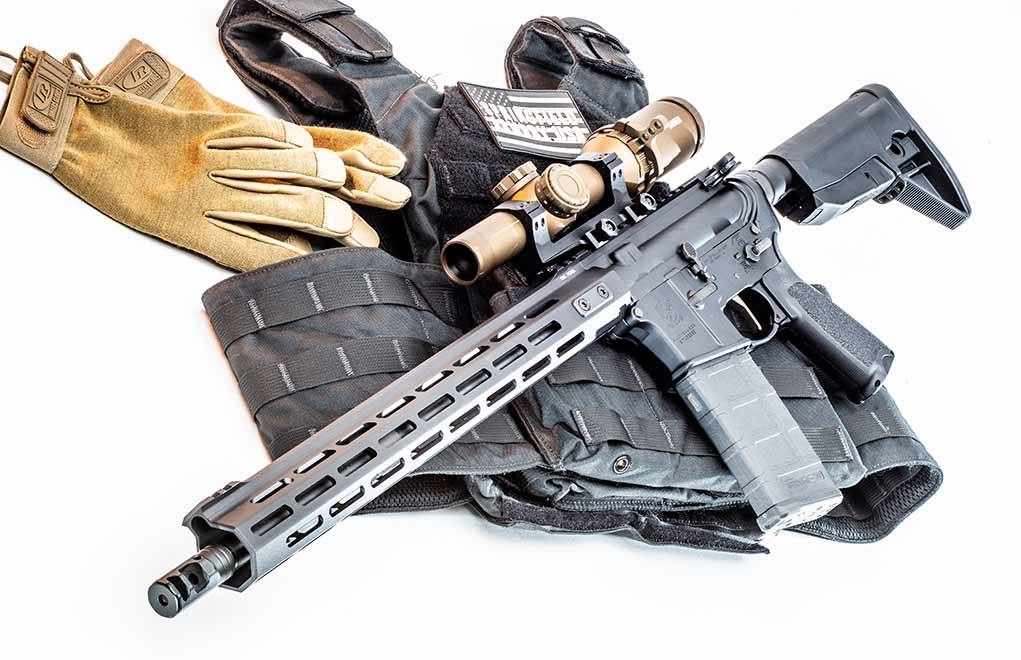
SAINT Victor Specs
Barrel Length: 16″
Caliber: 5.56 NATO
Weight: 6.56 lbs.
Capacity: 30
Twist: 1:8
Gas System: Mid-Length
Trigger: Nickel Boron Coated Flat GI
Muzzle Device: SA Muzzle Brake
Sights: Flip Up
Barrel Material: CMV
Receiver Material: 7075 T6
Stock: BCM Gunfighter Mod 0
Muzzle Thread: 1/2×28
MSRP: $1,150
Pros
- Outstanding Value for the Money
- Excellent Accuracy
- Refined Build Quality
Cons
- Muzzle Brake Side Blast
- Not Revolutionary
Springfield Armory didn’t reinvent the wheel with the SAINT Victor—it simply refined the AR-15 into something slick, capable and easy to recommend. This is my overall pick for a mid-tier AR-15 because, for the money, you get many of the features typically found in a premium rifle. We’ve run a lot of rounds through the Saint Victor and consistently find that it offers more bang for the buck than anything else in its class.
While there’s a wide array of options in the Victor line—including AR-10 and PCC variants—my choice is the original model. Springfield got it right the first time. If you need to save a few bucks, the B5 variant gives you everything the original does, swapping the BCM stock and grip for B5 versions. Both options work great.
One of the most noticeable features right out of the box is how tight the carbine feels, thanks to Springfield’s Accu-Tite tension system. At the range, it’s been absolutely on target—averaging around 1 MOA with nearly every type of ammo we fed it. Honestly, what more could you ask for? I also appreciate the handguard. It’s slender and nimble—as is now standard, M-Lok compatible—and works well for a modern C-clamp grip.
One feature that deserves mention is the dual-port brake. It works exceptionally well, keeping the rifle on target shot to shot. However, it also puts out plenty of blast to the sides—no big deal for you, but your neighbor at the range might not thank you for it. In terms of dependability, the Victor has never faltered through hundreds of rounds. Like any AR, though, keeping it clean and lubricated is key to preventing issues.
Want to know more? Check out our SAINT Victor review.
SAINT Victor Deals
Best Premium AR-15: SOLGW M4-76
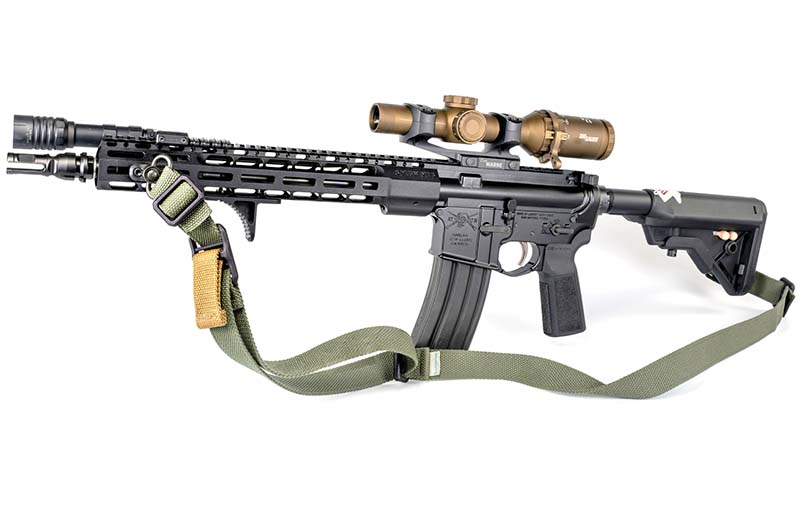
M4-76 Specs
Barrel Length: 13.7″
Caliber: 5.56 NATO
Weight: 7 lbs.
Capacity: 30
Twist: 1:7
Gas System: Mid-Length
Trigger: Liberty Fighting Trigger
Muzzle Device: NOX Flash Hider
Sights: None
Barrel Material: 4150CoMOV
Reciever Material: Aluminum
Stock: B5
Muzzle Thread: NA
MSRP: $1,800
Pros
- Exceptional Build Quality
- Soft-Shooting and Accurate
- Mission-Proven Pedigree
Cons
- High Price Point
- Pinned & Welded Muzzle Device
More than a few AR-15s on the premium end of the spectrum are designed to be safe queens. Not the M4-76. Sons of Liberty Gun Works built this rifle to be as tough as coffin nails—and that’s exactly what it is.
SOLGW’s quality control process is second to none, with each carbine practically hand-fitted as it comes off the line. That’s not just marketing speak—every component is meticulously inspected. If it’s not in spec, it doesn’t get used. The company also uses a more durable anodizing process and subtly tweaks upper receiver dimensions to eliminate wobble. That tight build is the first thing I noticed when I handled the M4-76—the gun was as tight as a drum.
No wonder SOLGW’s early adopters were SEALs and Marines.
The gun is as fast as it is accurate, thanks to Sons of Liberty making it one of the softest-shooting ARs I’ve shouldered. A lot went into its shootability, including a mid-length gas system, oversized gas port and a premium buffer setup. At 50 yards and in, engaging multiple targets, it simply sings. But the M4-76 isn’t just a CQB option. With the right optic—in this case, a Sig Tango6T 1–6×24—the 13.5-inch-barreled carbine can confidently reach past 500 yards.
As you may have noticed, the barrel length should technically make this an SBR—but it’s not. SOLGW pins and welds its NOX flash hider to the muzzle, making the rifle tax-stamp-free and quick-detach suppressor-ready. All in all, a true fighting carbine doesn’t get much sweeter than the M4-76. And when you invest in one, you’re paying for function—not flash.
Get all the ins and outs of the fighting carbine in our M4-76 review.
M4-76 Deals
Best Entry-Level AR-15: Smith & Wesson M&P15 Sport III

M&P15 Sport III Specs
Barrel Length: 16″
Caliber: 5.56 NATO
Weight: 6.52 lbs.
Capacity: 30
Twist: 1:8
Gas System: Mid-Length
Trigger: Mil Spec
Muzzle Device: A2 Flash Hider
Sights: None
Barrel Material: 4140 CM
Receiver Material: Aluminum
Stock: Adjustable M4
Muzzle Thread: 1/2×28
MSRP: $800
Pros
- Exceptional Value
- Excellent Reliability
- Solid Trigger for the Class
Cons
- Unremarkable Accuracy
- No Frills
While not as storied as some carbines on this list, it’s difficult to talk about the best AR-15s without mentioning the M&P15 Sport. Now in its third generation, the rifle remains among the most affordable on the market and has only improved over time.
For me, the key to the rifle is its reliability. Spartan as it may be, the Sport III chews through nearly anything it’s fed and takes abuse like a journeyman welterweight. Winning points, Smith & Wesson has added a slew of updates to the Sport that were long needed, all without affecting its bargain price.
What tops my list in the S&W upgrades is the handguard.Free-floated with ample M-Lok real estate, this feature brings the platform well into the future. Plus, a C-clamp grip is now more easily achievable. I won’t write home about the Sport III’s trigger any time soon, but I won’t bash it either. There’s some creep to it, and it’s not the smoothest I’ve felt. Yet, this unpleasantness is offset by a terse reset that’s both tactile and audible. Overall, I’d say it’s at the more polished end of mil-spec switches.
The accuracy of the Sport III is better than most entry-level ARs I’ve shot, but not exceptional. In testing, it averaged in the 1.5 MOA range when shooting supported at 100 yards. It’s not a tack driver but is more than adequate for most practical marksmanship. As far as entry-level guns go, the Sport III remains one of the most no-frills, hard-use rifles—or just plain fun guns—available today.
M&P15 Sport III Deals
Best Budget AR-15: Palmetto State Armory PA-15

PA-15 Specs
Barrel Length: 16″
Caliber: 5.56 NATO
Weight: 7 lbs.
Capacity: 30
Twist: 1:7
Gas System: Mid-Length
Trigger: Mil Spec
Muzzle Device: A2 Flash Hider
Sights: None
Barrel Material: 4150V
Receiver Material: 7075-T6 Aluminum
Stock: PSA Classic Carbine Stock
Muzzle Thread: 1/2×28
MSRP: $889
Pros
- Affordable
- Reliable After Break-In
- Decent Accuracy for the Price
Cons
- Subpar Factory Furniture
- Rough Charging Handle and Trigger
Squeezing the most out of your shooting budget? The PA-15 is the place to turn.
I’ve shot a lot of what PSA has to offer and have typically walked away fairly impressed with what the company brings to the table—particularly with its base AR-15, which usually rings up in the sub-$700 range for a complete rifle. PSA runs frequent sales, so expect the price to be considerably lower than MSRP when you go shopping.
The carbine I tested for this article—for full disclosure—was built from one of the company’s kits with a 16-inch barreled 5.56 NATO upper, with a mid-length gas system. This mimics the PA-15 complete rifle but saves a few bucks here and there—because I’m a cheapskate.
I sweated through a break-in period, with a few misfeeds right off the bench, but the carbine has since hit its stride. With more than 500 rounds downrange, the gun has not repeated its initial offense. Its accuracy is well within expectations, especially at this price point. I’ve never gotten it to dip below MOA but have gotten close. However, with cheaper ammunition, expect the rifle to shoot closer to or above 1.5 MOA.
The furniture is my main knock on the gun—it’s exactly what you’d expect from an entry-level carbine. The stock is what Palmetto calls its “Classic Carbine,” a fancy name for a generic M4-style unit. The grip is an A2 with the finger rest. I’m agnostic on this, though I prefer the A3 since it does away with the finger shelf.
The two upgrades I’d plan for with the PA-15 are swapping the charging handle and fire control group. Both are gritty and send chills up my spine every time I actuate one. However, if you’re a casual shooter or a first-time AR owner—is there still such a thing?—these issues might not even hit your radar.
PA-15 Deals
Best AR-15 for Consistent Accuracy: Geissele Super Duty MOD 1
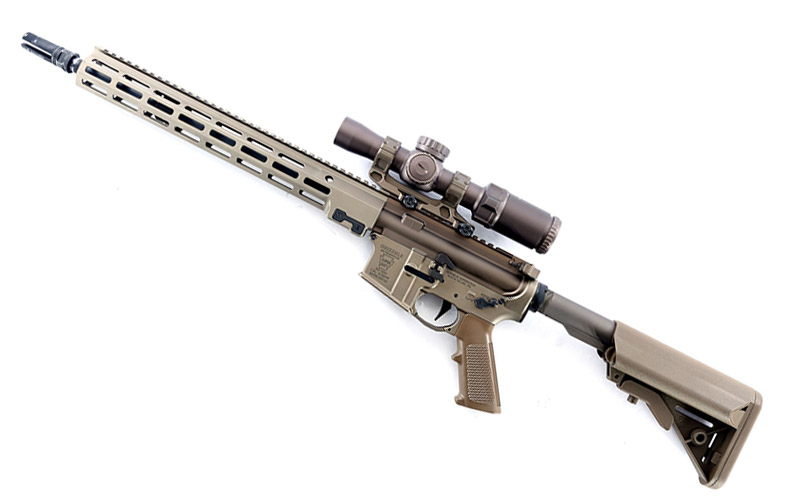
Super Duty Specs
Barrel Length: 16″
Caliber: 5.56 NATO
Weight: 7 lbs.
Capacity: 30
Twist: 1:7
Gas System: Geissele Length
Trigger: Geissele SSA-E X
Muzzle Device: HUXWRX Flash Hider
Sights: None
Barrel Material: Chrome Moly Vanadium
Receiver Material: 7075-T6 Aluminum
Stock: B5 Systems Enhanced Sopmod
Muzzle Thread: 1/2×28
MSRP: $2,035
Pros
- Exceptional Accuracy
- Top-Tier Components
- High Durability and Coating
Cons
- Expensive
- Heavy
If you want a precision shooter or a fighting rifle guaranteed to hit its mark—regardless of range—I recommend the Super Duty.
Our test of Geissele’s flagship rifle produced some of the best groups we’ve seen from any AR-15, aside from custom builds. Without reservation, I’ll say it’s a sub-MOA gun with most ammunition. At 500 yards, it turned in groups just a touch over 2 inches—impressive, even to the hard-to-impress.
These results aren’t surprising when you consider how Geissele builds the Super Duty—almost entirely from in-house components. The rifle is outfitted with a medium-profile, 16-inch barrel featuring a 1:7 twist, ideal for stabilizing heavier, better BC bullets. It also includes the excellent SSA-E X two-stage trigger—a standout in my opinion. Its straight bow design lends itself to consistent, predictable breaks.
The Super Duty is as tough as they come, with nearly every inch finished in Geissele’s Nanoweapon coating—a solid lubricant with a surface hardness rivaling synthetic diamond. Personally, I believe the 16-inch version is the most versatile, taking full advantage of the rifle’s inherent accuracy. However, Geissele also offers shorter-barreled carbines, pistols and SBRs if a CQB option better suits your needs.
Find out what makes this carbine so tough in our Super Duty review.
Super Duty MOD 1 Deals
Best Retro AR-15: Harrington & Richardson XM177E2
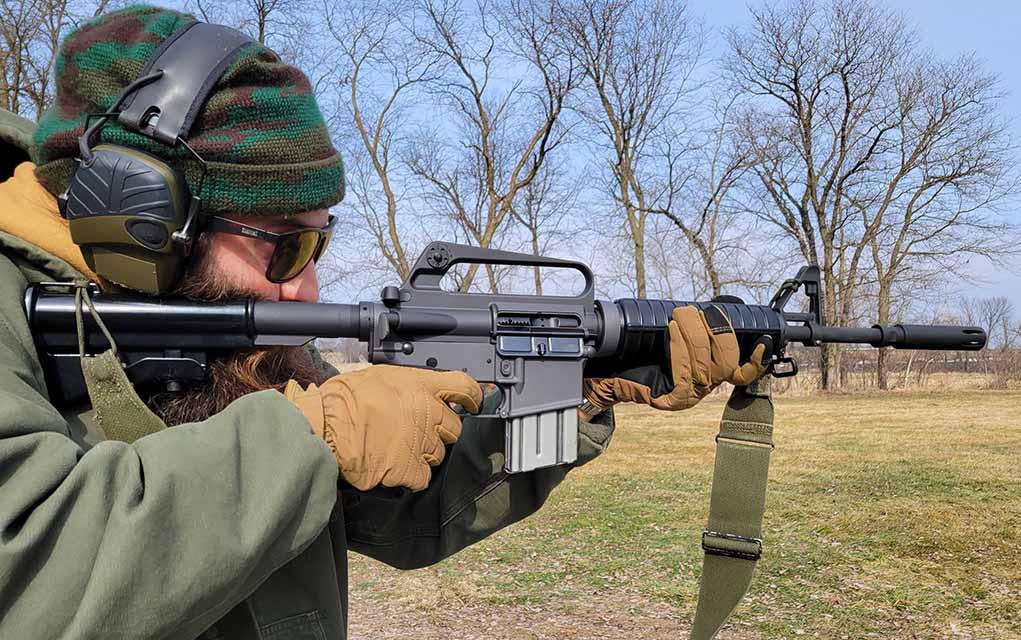
XM177E2 Specs
Barrel Length: 12.7″
Caliber: 5.56 NATO
Weight: 6 lbs.
Capacity: 30
Twist: 1:12
Gas System: Carbine
Trigger: Mil Spec
Muzzle Device: CAR Style Flash Hider
Sights: MA1 front, flip-adjustable rear
Barrel Material: 4150 CMV
Receiver Material: 7075-T6 Aluminum
Stock: Aluminum CAR-style
Muzzle Thread: N/A–muzzle device pinned and welded
MSRP: $1,200
Pros
- Retro Aesthetic
- Non-NFA Legal Compliance
- Solid Shooter
Cons
- Non-Functional Moderator
- Not a Perfect Clone
The granddaddy of the M4, the XM177E2 is one of the coolest historic AR designs—and now, thanks to PSA, it’s readily available. It’s my top pick for the best retro AR-15 on the market today. I love how well Palmetto State Armory nailed the aesthetics of the original H&R while keeping it a non-NFA firearm. Of course, that means a few tweaks to the design.
The XM177E2’s iconic moderator isn’t functional—it would reduce sound, thus would be classified a suppressor—but PSA replicates the look. And it’s pinned and welded to a 12.7-inch barrel, keeping the gun out of SBR territory. Hey, I said it was my favorite retro AR-15, not a perfect clone.
The furniture is correct, it sports the original’s gray anodized finish, ships with a retro-style mag and even features the correct 1:12 twist. It almost feels like it just rolled off a 1969 assembly line.
Better yet, the XM177E2 shoots. It was easy to ring a half-size silhouette at 100 yards in our testing, and through four magazines and more than 500 rounds, it only experienced one malfunction.
I’ll add this: the H&R isn’t just a throwback pleaser—it’s also a legitimate option for home defense. The XM177E2 may not be the most widely recognized retro AR-15, but it’s certainly one of the most unique and practical.
Why is this reto gun as sweet as it is short? Find out in our XM177E2 review.
XM177E2 Deals
Best Hunting AR-15: YHM HCR-160
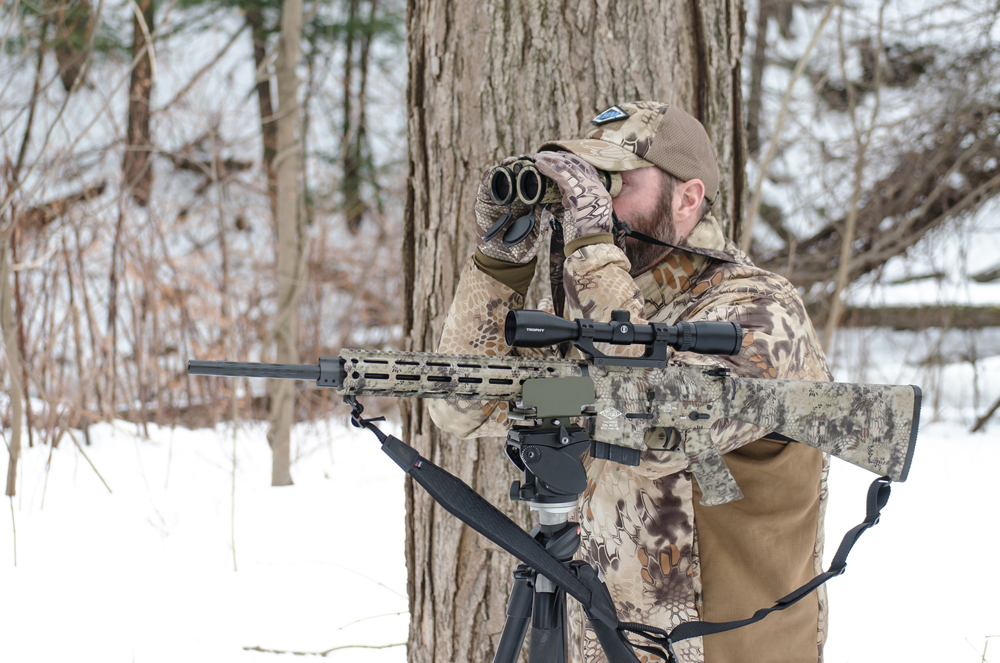
HCR-160 Specs
Barrel Length: 16″
Caliber: 5.56 NATO
Weight: 7.97 lbs.
Capacity: 30
Twist: 1:7
Gas System: Mid-Length
Trigger: Mil Spec
Muzzle Device: YHM Phantom 5C2 Flash Hider/Compensator
Sights: Bushnell® Trophy 3-9X40mm
Barrel Material: 4140
Receiver Material: 7075-T6 Aluminum
Stock: M4
Muzzle Thread: 1/2×28
MSRP: $1,768
Pros
- Field-Ready Out of the Box
- Excellent Hunting Accuracy
- Multiple Caliber Options
Cons
- Not Suited for Tactical Roles
Whether it’s hogs, coyotes or even deer, the HCR-160 is my pick for a hunting AR. It was, quite simply, built for the job.
Yankee Hill Machine ships the carbine ready to go right out of the box. It comes outfitted with a GrovTec sling and a Bushnell Trophy 3-9x40mm scope with a mil-dot crosshair reticle. You don’t even need to zero it—YHM delivers it sighted in at 100 yards.
Another big selling point: the HCR-160 is lightweight, tipping the scales at just under 8 pounds with all accessories installed. I’m personally not sold on the camo pattern, but it’s a useful touch for many hunters.
As far as chamberings go, my preferences are:
- .223 Remington: Coyotes and varmints
- .300 Blackout: Deer and hogs—especially suppressed
- 6.8 SPC: Deer and hogs at slightly longer ranges
We tested the .223 Remington version and found it more than accurate enough for most game. It grouped just over 1 MOA during our range time. Quite simply put, this rifle is ready to come straight from the box and into the field.
See how this carbine is ready for the hunt in our HCR-160 review.
HCR-160 Deals
Best Piston-Driven AR-15: LWRC ICMKII
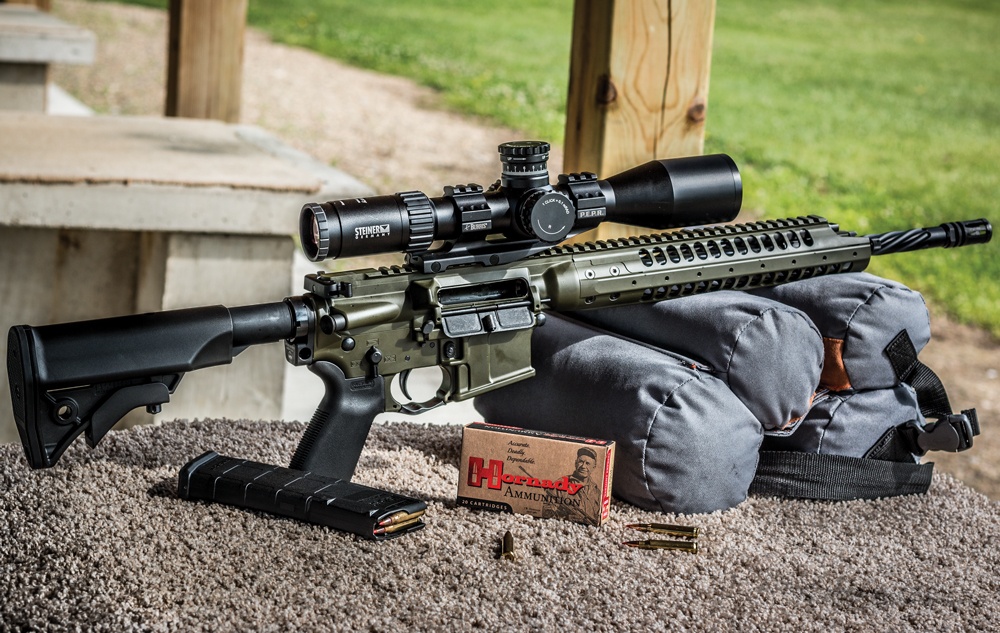
ICMKII Specs
Barrel Length: 16″
Caliber: 5.56 NATO
Weight: 7.3 lbs.
Capacity: 30
Twist: 1:7
Gas System: N/A
Trigger: Enhanced FCG
Muzzle Device: A2 Flash Hider
Sights: LWRCI Skirmish Back-up Iron Sights
Barrel Material: 41V45
Receiver Material: 7075-T6 Aluminum
Stock: LWRCI compact stock
Muzzle Thread: 1/2×28
MSRP: $2,865
Pros
- Ultra-Reliable Piston System
- Consistent Sub-MOA Accuracy
- Modernized, Versatile Handguard
Cons
- Higher Cost Than Direct Impingement Rifles
- Slightly Heavier Platform
If you’re looking for a rifle that doesn’t eat where it poops, the MKII is it. I’ve been a fan of LWRC’s piston-driven carbines since the M6IC-A5 days—and the updated MKII is better in nearly every way.
Its short-stroke gas-piston system is constructed from aerospace-grade superalloys that can withstand extremely high temperatures. In my experience, this is one of the most reliable AR-15s on the market—built to thrive in the worst conditions.
This proved out in our testing with zero malfunctions through hundreds of rounds. Not a complete surprise given this is a cleaner running system than gas impingement.
One of the most appreciated updates is the M-Lok handguard, now attached to a redesigned upper receiver. It lightens the platform slightly and provides much greater mounting versatility. LWRC also improved the two-position gas block with a paddle-style lever, making it far easier to operate than older versions.
We tested the 16-inch-barreled model, a lights-out performer that consistently printed sub-MOA groups during range time. For most users, the 16-inch version is the go-to—especially if you plan to stretch its legs at longer distances.
That said, the 14.7-inch model is slightly more nimble and better suited for home defense. If you need to maximize mobility, LWRC also offers 12- and 10.5-inch SBR and pistol configurations.
If you're going piston driven, you need to check out our ICMKII review.
ICMKII Deals
AR-15 Buyer's Guide
- AR-15: A Short History
- AR-15’s Desirability
- Breakdown Of The AR-15
- Receivers
- AR-15 Barrel
- Chambering
- Barrel Length
- Barrel Material
- Barrel Lining
- Barrel Rifling
- Types of Rifling
- Barrel Contours
- AR-15 Gas System
- Gas System Lengths
- Gas Bocks
- Bolt Carrier Group
- Barrel And Bolt Testing
- Handguards
- Buffer Tube
- AR-15 Trigger
A Short History Of The AR-15
Eugene Stoner designed the AR-15 in 1956 while working at Armalite, a smaller-caliber derivative of his earlier AR-10 design. A short aside for those who don’t know, the AR designation stands for “Armalite Rifle” and nothing else. In operation the rifles are identical, just the chamberings are different. The AR-10 was chambered for 7.62x51mm (or .308 Winchester), the AR-15 5.56x45mm NATO, an evolved version of the .223 Remington based off the .222 Remington varmint cartridge. Why go small? Essentially so a soldier could carry more ammunition into battle. As far as its effectiveness, there’s no doubt the 5.56 is deadly, but it remains a hot-button debate up to this day if it's optimal.

Anyhow, Armalite eventually sold the AR-10 and AR-15 rights to the company now most associated with the designs Colt. Under the guidance of the company, the rifle came under its first military contract by 1961 and was adopted by all United States Armed Forces in 1964.
This was a slightly redesigned model that was eventually designated the M16. Incidentally, today what is known as an AR-15—no matter what the chattering class tells you—is a much different animal to the original AR-15. What was produced in the ‘50s and ’60s was a select-fire rifle, whereas the modern variation is semi-automatic. Blame the confusion on Colt marketing folks, who designated the semi-auto civilian sporter model AR-15 to capitalize off its cousin’s military cred.
Over time, the rifle evolved to meet the military’s changing needs, until the M4 Carbine design was adopted in the 1990s. Barrel and gas system length are the changes here, with a 14.5-inch barrel and a carbine-length gas system. Overall, this is the most popular pattern found in AR-15s today, though the rifle comes in every shape and size. By The Way, AR-15 technically only applies to Colt rifles—they own the rights—hence the reason you find other manufacturers calling the gun all sorts of different names, such as Palmetto State’s PA-15.
AR-15's Desirability
There is little arguing the AR-15 is the most popular rifle of the late 20th and early 21st Century. In fact, it is the most owned rifle in America, which raises the question Why? Multiple reasons.
History: Yeah, it’s not the original military rifle, but is close enough to scratch most folks' vintage itch.
Shootability: The platform is very accurate at intermediate ranges and dang pleasurable to shoot. Most of the cartridges the rifle is chambered for are mild with little recoil.
Modularity: Next to its down-range performance this is the AR-15’s biggest selling point—you can tailor the rifle to exactly your preferences. Handguard, trigger, sights, grip, mag release, you name it and there’s an aftermarket upgrade. Bonus, most don’t require armors certification to add to a rifle.
Breakdown Of The AR-15
Getting to the rifle proper, there are numerous factors to consider when investing in an AR-15. Let’s skim over the major parts of the gun and hash out the importance of each and some specifics to look for when shopping.
Receivers
The AR-15 rifle has two receivers, the upper and lower. However, the lower carries special significance, given it is the part the Federal government technically considers the firearm. Hence the reason it is serialized. If you were to build a rifle from scratch, a very satisfying endeavor, you would require an FFL and background check to purchase even a stripped lower receiver. The upper, even a complete one—which includes all the internals, barrel and handguard—could be shipped directly to you without the need of a licensed intermediary.

The great majority of receivers are constructed from aircraft-grade aluminum alloy, usually 6061 and 7075. The numbers simply designate the type of alloy being used and sometimes include a sub-grade designation, such as “-T4” or “-T6”. These specify the temper placed on the aluminum, that is, how the alloy was heat treated.
There are two types of lower receivers billet and forged. Billet receivers are produced from a single block of aluminum that is machined into the profile of a lower. It’s a more time-consuming process, however, it yields more unique designed and integrated features. Forged receivers are made by hammering two roughly shaped halves of aluminum, then machining the profile later. This is the more affordable of the two methods, given machining is kept to a minimum.
Which is better? That’s a can of worms, given billet and forged receivers each have the advocates. Overall, forgings tend to be more durable, given the alloy’s grain structure remains intact. But billet receivers achieve tighter tolerances.
Barrel
Simple as a fire tube seems, there the AR-15 barrel is a multi-faceted topic. Let’s delve into what you’ll find when you shop for a rifle.
Chamberings
Quite simply, the chambering is what type of cartridge the rifle shoots. And the AR-15 shoots quite a few cartridges. Richard Mann has an excellent piece on AR-15 calibers if you want to survey what’s out there. However, by far the most popular chambering is 5.56x45mm NATO and accounts for nearly every option on our list below.
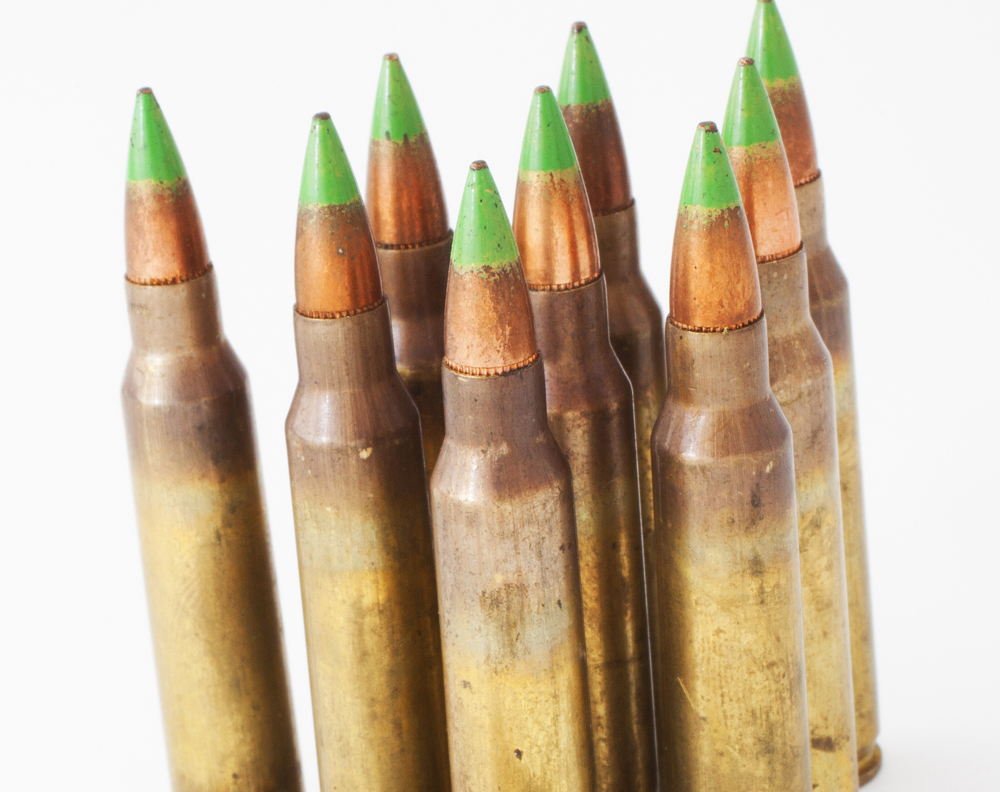
If this is your first endeavor into AR-style rifles, the common caliber is a solid choice. Outside of buying panics (hello 2020 and 2021), it is widely available and generally affordable. It’s also lights out at intermediate ranges, is an absolute Thor’s hammer versus varmints and is legal in many states to take deer. Also, it’ll do a number on a home invader.
While the 5.56 NATO is essentially a .223 Remington, the two are not interchangeable. Patrick Sweeney gives the nitty-gritty on the .223 vs 5.56 if you're interested in specifics. For our purposes this is what matters:
- A 5.56 NATO barrel will shoot both 5.56 and .223 Remington.
- A .223 Remington barrel will only shoot .223 Remington.
- A .223 Wylde will shoot both 5.56 and .223 Remington.
Barrel Length
While you won’t find them on a production rifle, there are 26-inch AR-15 barrels in this world. At the other end of the spectrum 4-inch options. Also everything in between. On the surface, it’s a bit of a muddle on what to choose, but law and performance help thin the field fairly quickly.
By Federal law, a rifle must have a 16-inch barrel, which can include a permanently affixed muzzle device (i.e. suppressor, muzzle brake). Go any shorter and the gun is considered a Short Barrel Rifle (SBR) and requires a tax stamp and registering it. For most, these are a hurdle not worth crossing, in turn, 16-inches is the basement. The ceiling, unless you get into custom rifles, is 20-inches on most production offerings.
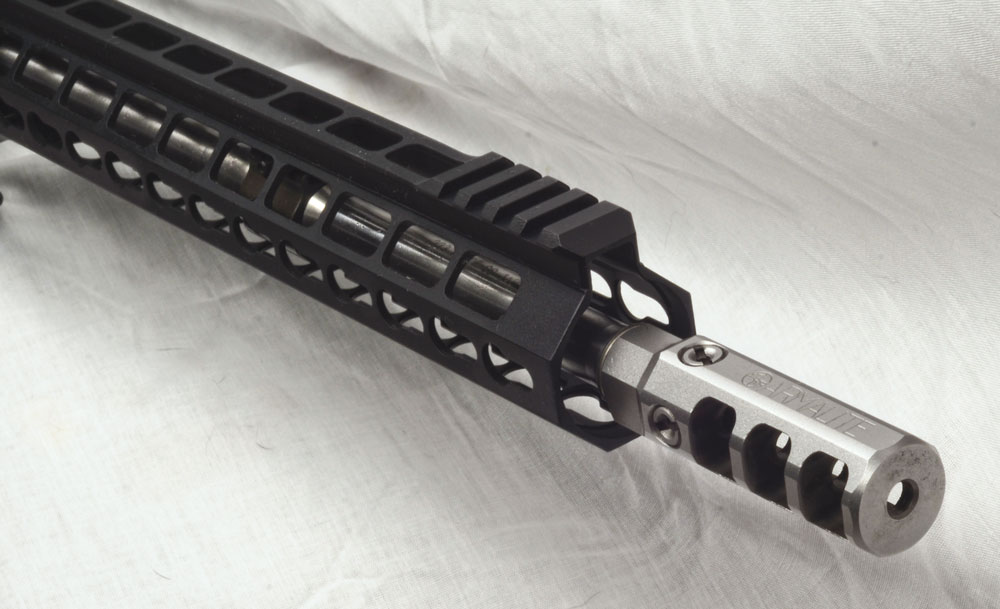
As for performance between the top and bottom, it’s marginal. In general, a 20-inch rifle produces more velocity, given it has more bore, thus ensuring a more complete powder burn. But it will only beat out a 16-inch AR by roughly 150 to 200 fps at the muzzle. In many shooter’s books, it’s a marginal difference, which tends to give the shorter barrel the advantage. With the same contour, the 16-inch barrel is stiffer, thus suffers less barrel whip and is much more nimble.
However, if you aim to milk as much range from an AR-15 as possible, the 20-inch flavor might be your cup of tea. It’ll produce greater velocity, thus get the bullet where it’s going faster and narrow the window in which wind and gravity work upon it.
Barrel Material
Barrels are either made of carbon steel or stainless steel. Here are the most common of each.
Carbon Steel
4140: The most affordable steel, the alloy contains .80 to 1.10 percent chromium, .15 to .25 percent molybdenum and .40 percent carbon. The materials increase the strength and hardness above standard carbon steel.
4150: Also containing chromium and molybdenum, this steel has .50 percent carbon. The steel has higher tensile strength, however, requires a stress-relieving treatment, thus is more expensive.
Chrome-Moly Vanadium (CMV): Developed by Colt, the steel is the official mil-spec material used in the military’s M16 and M4 rifles and carbines. Essentially, it's 4150 steel with the addition of Vanadium, which significantly increases strength, hardness and stability in high temperatures.
4150 CMV, 41V50 Steel or 4150 V: Same as CMV, but the name’s been dolled up for marketing purposes.
MIL B-11595: It’s not steel, but a specifying document of the materials used in a mil-spec barrel. Some companies slang it up and use this designation for CMV barrel just to sound cool and confuse the entire world.
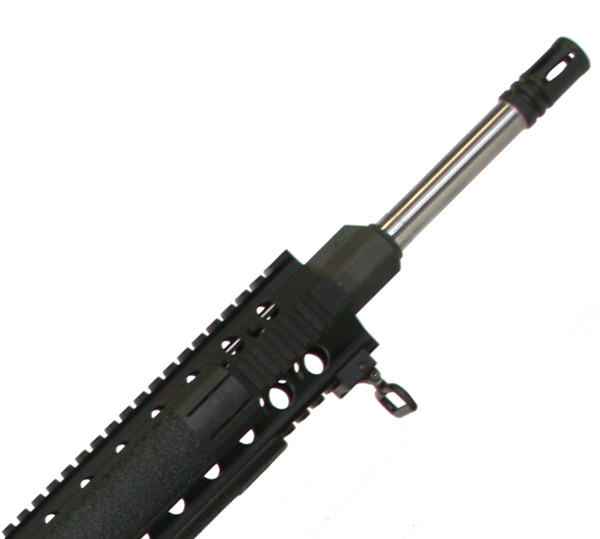
Stainless Steel
410: A stainless steel that includes molybdenum and is known for its durability (perhaps the best of the lot). However, it is not recommended for cold-weather duty. Below freezing, the risk of cracking is increased.
416: A highly machinable stainless steel, thus allowing for better rifling and performance. However, it is less corrosion resistant than 410. Not the top choice of the lot.
416R: A proprietary alloy from Crucible Industries, it's normal 416 stainless with molybdenum added. It machines like 416, however, has superior low-temperature performance and corrosion resistance.
17-4 PH: Known for its high strength, corrosion resistance, good mechanical properties and toughness. Precision shooters love barrels made from 17-4 PH, given the extreme uniformity and smoothness of the rifling—that and a barrel will last 3 times as long. However, the process in which its made—precipitation-hardening (PH)—makes it expensive.
Barrel Lining
Yup, there’s something in the AR-15’s bore (in many cases) besides rifling. Barrel linings are found in carbon steel barrels and improve their corrosion resistance and improve their longevity. Note, some manufacturers do not line their barrels, which isn’t a sin against God. If you’re in the market for a causal target rifle you’ll take out occasionally and care for properly, a non-lined barrel will get the job done. Harder use on the horizon, consider a barrel with this lining.
Chrome: The longest and perhaps most-used lining, Chrome reduces the effects of friction and heat on the barrel proper. Additionally, it makes cleaning much easier. This all adds life to the barrel. However, the process is known to reduce a rifle’s accuracy, though not to the extent that renders it useless. Most casual shooters won’t know the difference.
Ferritic Nitrocarburizing (FNC): Most likely you see FNC lining called something different, usually Melonite or Nitride. It’s essentially a case-hardening process that diffuses nitrogen and carbon into the steel. Thus treated a barrel can withstand direct exposure to water, heat, salt and corrosive elements better than any other process. Additionally, since it does not add material, it maintains the barrel’s accuracy.
Barrel Rifling
Manufacturers use different methods to apply the rifling to the barrel’s bore. Some methods are better for certain applications, here’s a look.
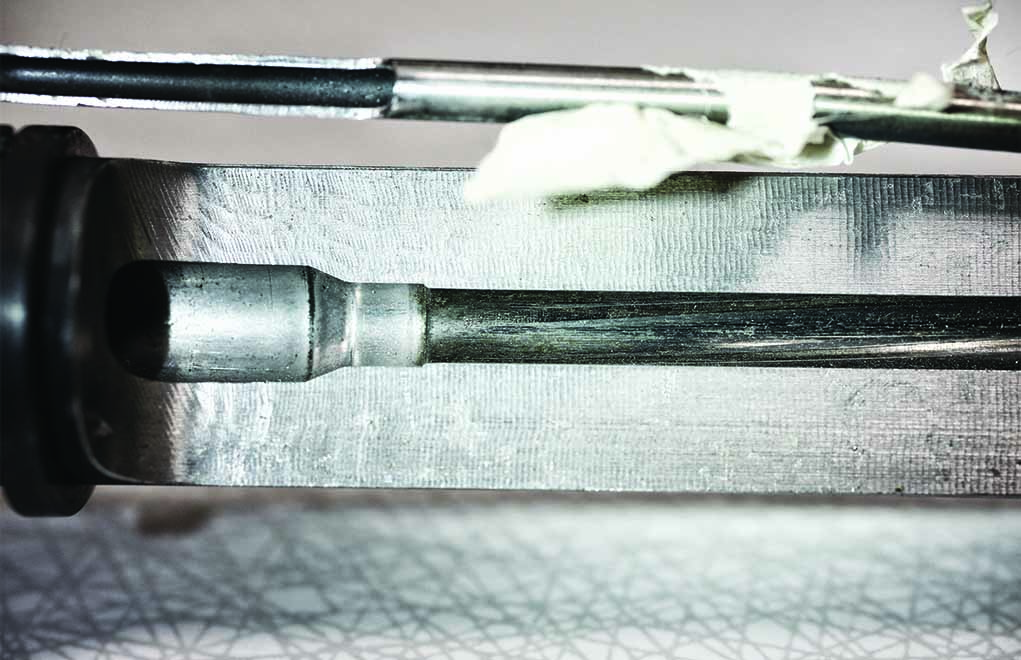
Cut Rifling: The oldest method of rifling a barrel, the process removes metal from the bore using a single-blade, hook-type cutter. Each groove is cut individually and with multiple passes, making it time-consuming and expensive. However, it introduces no additional stress to the barrel and tolerances can be kept tight.
Broach Rifling: Very similar to cut rifling, except a multi-bladed broach (metal bar) is used to cut successively deeper grooves. All the rifling is cut at once and in a single pass. This is a more affordable method with little stress placed on the barrel that has very consistent results through the entire bore. Broach rifling a barrel, relative to other methods, is still expensive.
Button Rifling: Essentially, a button of tungsten carbide with a reverse of the rifling is drawn through the bore displacing metal to lay down the pattern. It is a fairly economical system that turns out excellent results. The lands and grooves are very uniform and have a smooth finish. However, this method puts stress on the barrel that typically must be relieved afterward.
Cold Hammer Forged (CHF): A tungsten-carbide mandril is run into a roughly shaped barrel blank and the rifling is hammered into the bore. Overall, a majority of AR-15 barrels are made in this fashion and they are extremely popular with shooters. Tough as nails, these barrels withstand a lot of abuse. However, the barrels must be stress-relieved after the process and CHF doesn’t produce the uniformity of the other processes. Though, most shooters won’t notice.
Types of Rifling
This used to be cut and dry, but with the advent of 5R rifling has become a factor. What is 5R rifling, simply put the leads are opposite of the grooves and tapered. The idea behind this is to create less bullet deformation, thus maintaining ballistic integrity. Additionally, it’s supposed to be easier to clean. Traditional rifling still dominates the AR-15 market—lands opposing lands, with no taper. The jury is still out on if one outperforms the other.
Barrel Contours
Barrel contours, or barrel profiles, are simply the shape of the barrel. On the surface, a fire tube’s form might not seem like much, but it has an effect on performance and the AR-15 manageability. Thick and heavy bull barrels tend to take longer to heat up, suffer less barrel whip and maintain their harmonics better. The trade-off, their heavy and not something most folks want to hump around. Conversely, thin pencil barrels are light and make for a fairly nimble rifle, but heat up quickly and become “whippy”.
Fluting can provide an acceptable middle ground, removing material lengthwise along the barrel. This helps maintain rigidity, creates more surface area to dissipate heat and lightens an AR-15’s burden. Still not as much as other styles. Here’s a brief overview of common AR-15 barrel contours.
A1: The original pencil barrels found on the M16A1 rifle.
A2: Heavier profile forward of the gas port, found on the M16A2 rifle.
M4: Thin near the chamber, heavy just before and after the gas port, found on the M4 carbine.
Government: Same as the M4, but lacks the grenade launcher cut.
Heavy: Like it sounds, a thick bull barrel.
Gas System
The gas system power behind how the gun cycles. The gas from the conflagrated powder behind the bullet is bled off and either moves the bolt-carrier group (BCG) or a piston. Here’s a brief overview of each.
Direct Impingement (DI): This is the system that directs gas back to the receiver to move the BCG. It is extremely light and does nothing to infringe on an AR-15’s accuracy. However, it injects a good deal of carbon and fouling into the receiver, meaning the shooter must stay up on cleaning detail.
Piston: Gas forces a piston rearward which moves the BCG. While this keeps the receiver clean and is a somewhat more robust system, it does have its flaws. Pistons-driven guns are known for being less accurate, heavier and more expensive.
Gas System Lengths
The length of a gas system is determined by the distance to the gas port (where gas is bled). There are four lengths.
Pistol: 4 inches
Carbine: 7 inches
Mid-Length: 19 inches
Rifle: 12 inches
Gas Bocks
On a DI AR-15, the gas block is what diverts the gas from the barrel into the gas tube, thus back into the BCG. Most entry-level guns utilize a front sight base style gas block, in which the block is integral with the front sight. However, low-profile gas blocks, which reside under the handguard, are becoming more common.
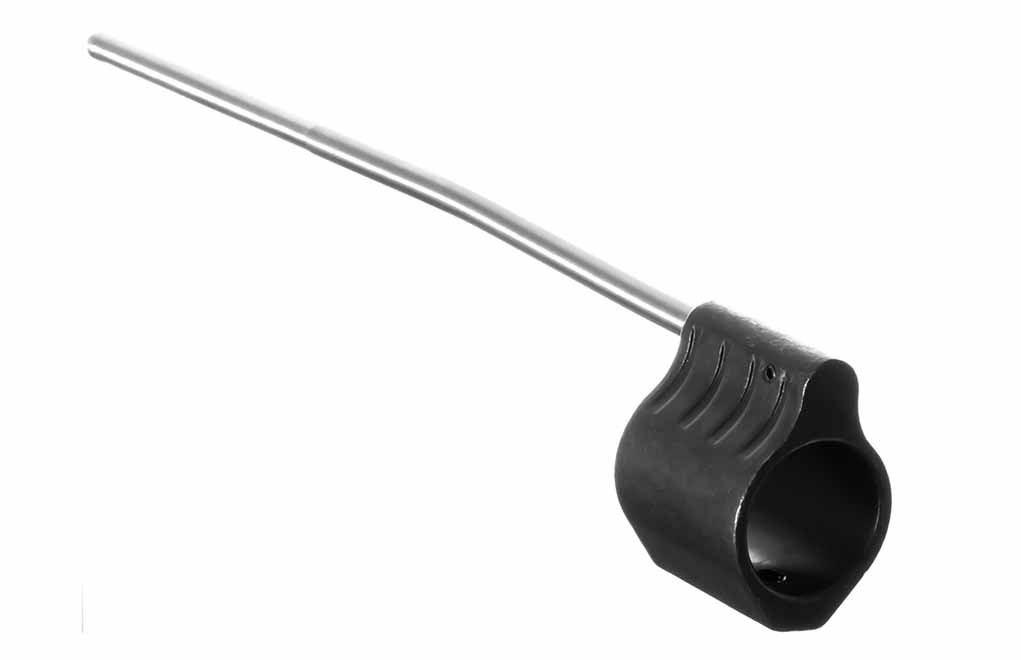
Bolt Carrier Group
The bolt carrier group is where a lot of the action happens in the rifle’s operation. The component loads the fresh round, fires it and ejects the spent case. Essentially it’s made up of four main components.
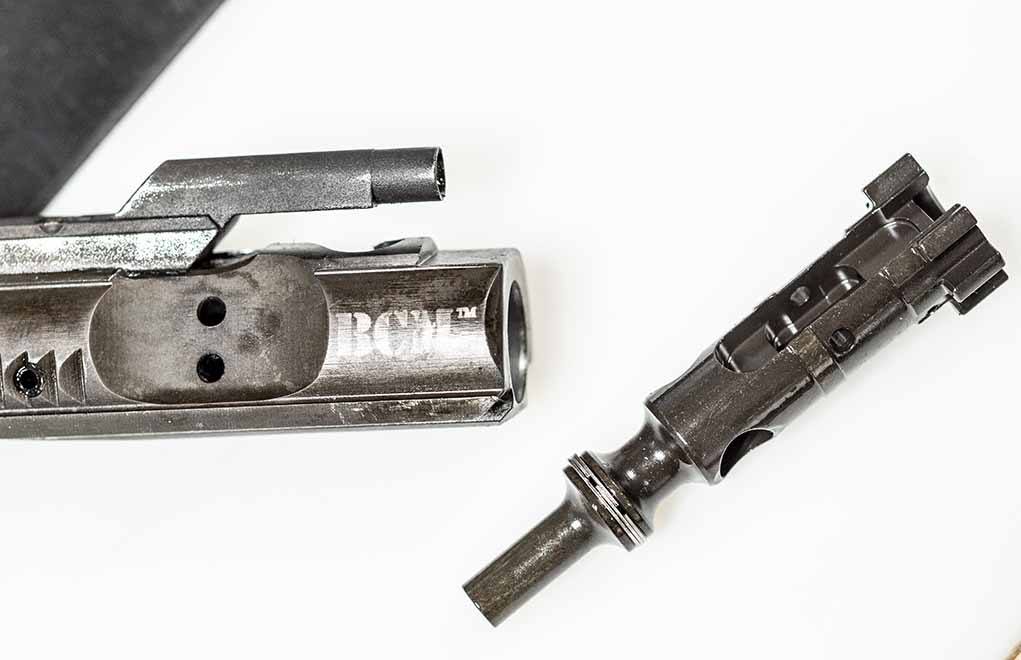
Bolt: The rotating bolt locks the chamber for firing, as well as strips a fresh round off the magazine. It also has an extractor, whose job is to pull the spent case out and eject it from the receiver. Bolts are typically made of one of three kinds of steel, Carpenter No. 158, 860 or 9310.
Carrier: The heart of the BCG, it houses all the other components and does all the heavy lifting. It deals with a ton of force and thus must be well made from tough material, the same kinds of steel as the bolt.
Gas Key: The small cupped device at the top of the BCG. It catches the diverted gas to thrust the BCG rearward, thus cycling the rifle.
Gas Rings: Traps the expanding gas, allowing it to operate the bolt.
Cam Pin: Stops the bolt from over-rotating when unlocking and keeps the cam pin, bolt, and firing pin rotating and moving as one unit.
Firing Pin: Strikes the primer to initiate the firing process.
Barrel And Bolt Testing
Most manufacturers give a damn about the quality of their products, thus test them for imperfections. There are two main tests Magnetic Particle (MP) and High Pressure (HP). Each is designed to detect any cracks or flaws in barrels and bolts, each component should be stamped with the acronyms if they’ve gone through the procedures.
Handguards
More the preventing you from singing your hand, many handguards serve as an accessory attachment point. Two of the most popular systems to this end are M-Lok and Keymod—the former more prevalent. As to the types of handguards, there are two main varieties: free-floated and non-free-floated. As the name suggests, it is all determined by if the handguard makes physical contact with the barrel. Free-floated handguards a preferred as they enhance the accuracy potential of a rifle. But non-free-floated will get the job done without knocking a gun too far off-kilter.
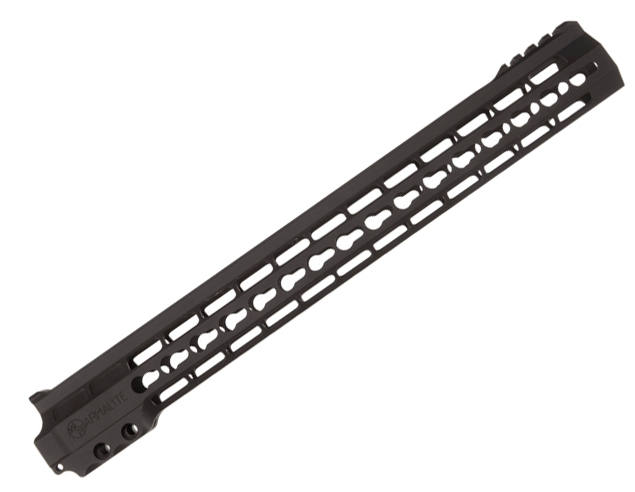
Buffer Tube
This is the protrusion on the rear of an AR-15, where the buttstock attaches. It housed the buffer spring and weight, whose jobs are to slow the rearward path of the BCG and return it forward.
Triggers
Next to the AR-15’s performance, modularity is perhaps the gun’s greatest attraction. From buttstock to front sight post, there isn’t a facet of the rifle that can’t be fiddled to perfection. Needless to say, your options are legion and far too vast to cover here. Instead, we’ll zero in on one feature of the gun you should consider at the top of your AR-15 upgrade list—its trigger.
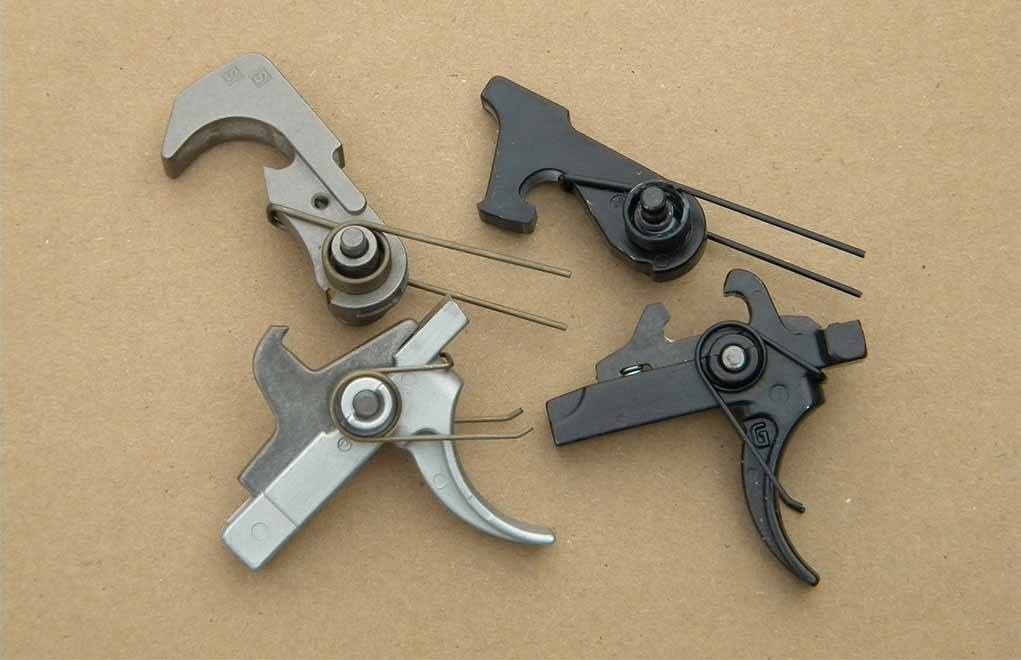
By and large, what is known as a mil-spec trigger is a nasty beast. It’ll get your gun to go BANG!, but it won’t do much to enhance its performance. As you progress as a shooter, you’ll find those crunchy, gritty, squishy triggers detract from your accuracy potential. Thankfully, putting a better bang switch into your rifle is among the simplest upgrades and for the money one of the best values. With that in mind, it’s wise to factor an extra $100 to $200 into the base price for an upgraded AR-15 trigger. Yeah, it ups your investment, but you won’t find it a waste of money by any stretch.
Overall, there was no true AR brand. ArmaLite (where “AR” comes from in the carbine’s name) produced the first prototype AR-15 in 1957, a scaled down version of the carbine’s predecessor, the AR-10. However, ArmaLite sold the AR-15 design to Colt in 1959, who introduced a mass-produced model in 1964.
The U.S. Military does not use the AR-15 rifle. The primary infantry weapon for the U.S. Army and U.S. Marines is the M4 Carbine. While based on Eugene Stoner’s original design, it is a select-fire carbine, whereas the civilian AR-15 is semi-automatic. As for the M4s, they are manufactured by FN America.
Overall, a shorter barreled AR-15 is the best choice for home defense, as it is easier to maneuver in the close quarters of a home. For those not interested in acquiring a NFA firearm, the best options would be a 16-inch barreled carbine or 10.5-inch barreled AR pistol. At 10.5 inches, the gun is very nimble, but still has a strong ballistic profile. For those willing to do the paperwork, a 10.5-inch barreled SBR would be a solid choice. These shorter guns also allow for the addition of a suppressor without making them unwieldy.
AR-15s were never outrightly banned at the federal level but was caught under the now sun-setted 1994 Assault Weapons Ban. This ban focused on superficial elements of semi-automatic firearms mainly as feel-good legislation and as a political football. Proponents of such legislation generally point to crime reduction as the goal, though firearms such as the AR-15 are rarely used to commit crime. However, some states do have laws that ban the sale of AR-15s or otherwise prohibit certain standard features like pistol grips for similar reason.
AR-15 Essential Reads
- AR-15 Buying Guide – Options For Any Budget
- Differences Between AR-10 and AR-15 – How Stoner’s Rifles Stack Up
- Best AR-15 Accessories & Parts
- AR-15 Lower Internals Setup
- How To Setup AR-15 Upper – A Complete Guide
- Buyer's Guide: Best Pistol Braces for ARs
- Affordable AR Pistol Options
- Best AR-15 Cartridges – What Should You Chamber Your Carbine?

Next Step: Get your FREE Printable Target Pack
Enhance your shooting precision with our 62 MOA Targets, perfect for rifles and handguns. Crafted in collaboration with Storm Tactical for accuracy and versatility.
Subscribe to the Gun Digest email newsletter and get your downloadable target pack sent straight to your inbox. Stay updated with the latest firearms info in the industry.


![Best Concealed Carry Guns In 2025 [Field Tested] Wilson Combat EDC X9S 1](https://gundigest.com/wp-content/uploads/Wilson-Combat-EDC-X9S-1-324x160.jpg)


![Best 9mm Carbine: Affordable PCCs [Tested] Ruger Carbine Shooting](https://gundigest.com/wp-content/uploads/Ruger-Carbine-Shooting-100x70.jpg)
![Best AR-15: Top Options Available Today [Field Tested] Harrington and Richardson PSA XM177E2 feature](https://gundigest.com/wp-content/uploads/Harrington-and-Richardson-PSA-XM177E2-feature-100x70.jpg)

Overall, this is a decent intro the AR platform.
As noted above, the Ruger 556 is 5.56NATO/.223, and it also comes in .300 BO, .350 Legend, and .450 Bushmaster. I’d never describe Ruger as offering clockwork performance here — in my experience Ruger ARs fall well below Palmetto State Armory and may equal Del-Ton and Springfield for hit-or-miss QC. I’d not buy or recommend Ruger, Del-Ton, or Springfield ARs, let alone put them in this guide.
Where is Aero Precision? As often similar to PSA, S&W, or Anderson, they too are superior or equal to some of the brands on this list. Why is, the niche brand at best, Core Rifle Systems on this list?
Typos above: Mid-length gas systems are said to be 19″ when the full-length is 12″! It’s not spelled “Sig Saure” either.
To make an informed decision, consumers should consider factors such as quality, potency, flavor profiles, and customer reviews. By evaluating these aspects, individuals can find how much Dispo Carts that aligns with their preferences and expectations.
I’ve got Springfield’s Saint Victor in .308 and it’s hands down best “value” rifle out there. Previously was mostly running Savage, but decided to switch after reading a few articles on SV rifles( https://gritrsports.com/shooting/firearms/rifles/ went for .308 from Gritr since I’ve already had 5.56 AR).
The Ruger AR-556 is NOT “As its name implies its strictly a 5.56”. Very misleading statement for a “Gun Digest”. It implies, especially for the newbie, that it only uses 5.56 ammo. The AR-556 IS chambered 5.56 but unlike a .223 chambered firearm that only supports .223 ammo, a 5.56 chambering will shoot .223 AND 5.56 safely and effectively.
Great write-up. Very informative for anyone.
AR-15 is the most popular rifle of the late 20th and early 21st Century. I personally love Ruger AR-556. Its really vey good for new hunters.
being new to the AR platform I did some looking research and shopping, and found an ATI Omni in 300 BLK on sale online about a year ago for around $349. From my research, I was hoping that the caliber would become more popular and therefore cheaper, but so far not so. Still, There are a number of options in weight, tip and muzzle velocity for the caliber, (I have Armscor 208 gr A Maxx for home defense) and I like the 30 cal punch. The trigger is crisp and predictable, around 5 lb. The ATI rifle as received required a few tweaks, mostly tightening the keymod screws, but it sends rounds downrange without fail and at a good price, and the keymod grip accommodates infinite accessories. ATI’s customer service has been great. The ATI Omni is available in other chambers as well, and can be found for under $400. I think is a good entry level AR for a shooter on a budget, but the 300 BLK ammo isn’t so much for the budget-minded. Daisy ain’t no Sig, but she spits fire accurately and dependably.